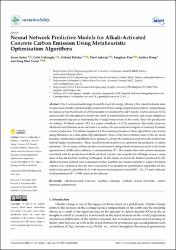Neural network predictive models for alkali-activated concrete carbon emission using metaheuristic optimization algorithms

Göster/
Erişim
info:eu-repo/semantics/openAccessTarih
2023Yazar
Çakıroğlu, CelalAydın, Ceren
Bektaş, Gebrail
Işıkdağ, Ümit
Kim, Sanghun
Hong, Junhee
Geem, Zong Woo
Üst veri
Tüm öğe kaydını gösterKünye
Çakıroğlu, C., Aydın, C., Bektaş, G., Işıkdağ, Ü., Kim, S., Hong, J., Geem, Zong W. (2023). Neural network predictive models for alkali-activated concrete carbon emission using metaheuristic optimization algorithms. Sustainability, 16 (142), 1-19.Özet
Due to environmental impacts and the need for energy efficiency, the cement industry aims
to make more durable and sustainable materials with less energy requirements without compromising
mechanical properties based on UN Sustainable Development Goals 9 and 11. Carbon dioxide (CO2
)
emission into the atmosphere is mostly the result of human-induced activities and causes dangerous
environmental impacts by increasing the average temperature of the earth. Since the production
of ordinary Portland cement (PC) is a major contributor to CO2 emissions, this study proposes
alkali-activated binders as an alternative to reduce the environmental impact of ordinary Portland
cement production. The dataset required for the training processes of these algorithms was created
using Mendeley as a data-gathering instrument. Some of the most efficient state-of-the-art metaheuristic optimization algorithms were applied to obtain the optimal neural network architecture
with the highest performance. These neural network models were applied in the prediction of carbon
emissions. The accuracy of these models was measured using statistical measures such as the mean
squared error (MSE) and coefficient of determination (R2
). The results show that carbon emissions
associated with the production of alkali-activated concrete can be predicted with high accuracy using
state-of-the-art machine learning techniques. In this study, in which the binders produced by the
alkali activation method were evaluated for their usability as a binder material to replace Portland
cement, it is concluded that the most successful hyperparameter optimization algorithm for this
study is the genetic algorithm (GA) with accurate mean squared error (MSE = 161.17) and coefficient
of determination (R2 = 0.90) values in the datasets.
















